Do you lack the space needed to grow the amount of produce that you want? Think again.
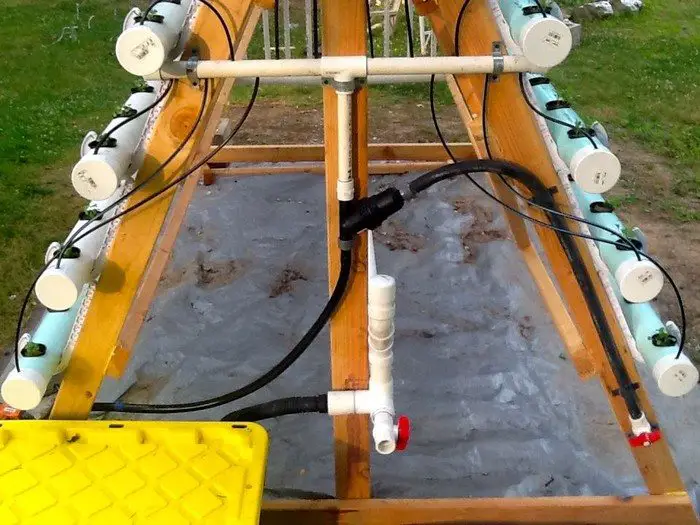
Whether you don’t have enough garden area or space, you can still plant a relatively abundant amount of produce with an A-frame hydroponic system!
An A-frame hydroponic system lets you grow at least twice the amount of plants from a regular garden bed. For instance, the featured structure you see above accommodates 168 plants in just a 6′ x 10′ space.
Not having to stoop down to check and tend to your plants is also a great bonus with this garden. ;)
The most important part of this system is monitoring your water temperature. You should maintain it at around 65 degrees for optimal water oxygenation, thus preventing root rot.
You don’t have to worry about root development as the length of the pipes is enough for a full root growth of your plants!
This gardening system is definitely great for planting herbs, and some fruits and vegetables!
Do you know anyone who could use an A-frame hydroponic system?
Contents
Building an A-Frame Hydroponic System
Materials
- Timber (for frame)
- 3-inch Sewer/Drain Pipe
- 3/4-inch Pipes
- 1/4-inch Water Hose Pipes
- Pipe Connectors and Caps
- Pipe Brackets
- Digital Thermometer
- O-ring/Silicone
- Plastic Bin (water reservoir)
- Cable Mount
Tools
- Measuring Tape
- Drill
- Mitre Saw
- Pipe Cutter
Steps
Step 1: Build the A-Frame Structure
- Measure and Cut the Timber
Cut your timber pieces to the exact lengths needed to create an A-frame construction with a measuring tape and mitre saw. A conventional design might call for two equal-length sections for each side of the frame and a crossbar to provide structural stability. - Assemble the Frame
Drill holes in the timber where the pipes will be attached later. To create the A-shape, fasten the timber pieces together with screws or nails. Make sure the frame can carry the weight of the pipes and plants without wavers.
Step 2: Prepare the Pipes
- Cut the 3-Inch Sewer/Drain Pipes
Cut the 3-inch pipes to suitable lengths with a pipe cutter. Your plants will be kept in channels made of these Make sure the pipe lengths fall inside the A-frame. - Drill Holes in the Pipes
Along the three-inch pipes’ length, drill evenly spaced holes. Seedlings will be planted out of these holes. The hole should fit your net cups or plants rather comfortably. - Cap the Ends of the Pipes
Attach pipe caps to both ends of each 3-inch pipe. This will prevent water from leaking out and ensure proper water circulation.
Step 3: Assemble the Water System
- Attach the 3/4-Inch Pipes
Using pipe connectors, attach the 3/4-inch pipes to the bottom of the 3-inch drain pipes. These will serve as the return pipes, bringing water back to the reservoir. - Install the 1/4-Inch Water Hose Pipes
Connect the 1/4-inch water hose pipes to your water pump (inside the reservoir). Run the hoses through the A-frame and into the top of each 3-inch pipe, allowing water to flow through the system. - Secure with Pipe Brackets
Use pipe brackets to attach the 3-inch pipes securely to the A-frame. Ensure they are evenly spaced and can support the plants’ weight.
Step 4: Set Up the Water Reservoir
- Position the Plastic Bin
Place the plastic bin at the bottom of the A-frame. This will act as the water reservoir for your hydroponic system. - Seal the Connections
Use O-rings and silicone to seal any joints or connections that may leak. This is important for maintaining water flow and preventing wastage.
Step 5: Monitor Water Temperature
- Install the Digital Thermometer
Place the digital thermometer in the water reservoir to monitor the water temperature. Ideally, keep the water around 65°F (18°C) for optimal plant growth.
Step 6: Test the System
- Run the Water Pump
Test the water flow by turning on the water pump. Ensure that water flows through the hoses, fills the 3-inch pipes, and returns to the reservoir via the 3/4-inch pipes. - Check for Leaks
Inspect the system for leaks or weak points. Adjust pipe connections and seals if necessary.
Step 7: Plant Your Seedlings
- Add Seedlings to the System
Place your seedlings in the holes you drilled in the 3-inch pipes. Make sure the roots are properly submerged in the nutrient solution.
Click on any image to start lightbox display. Use your Esc key to close the lightbox.![]()
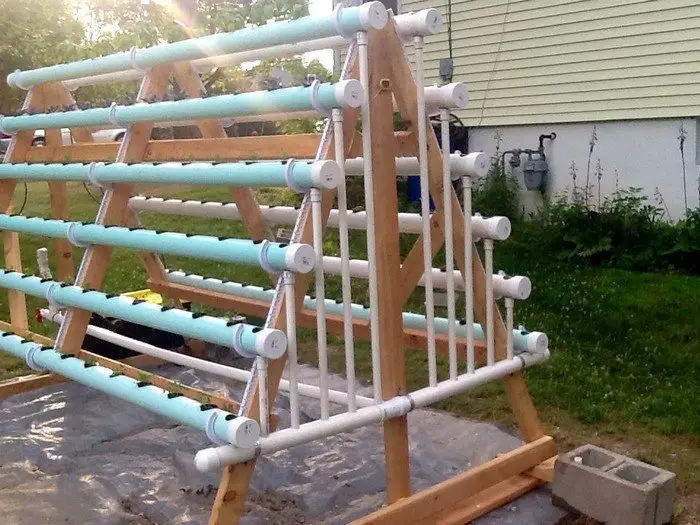
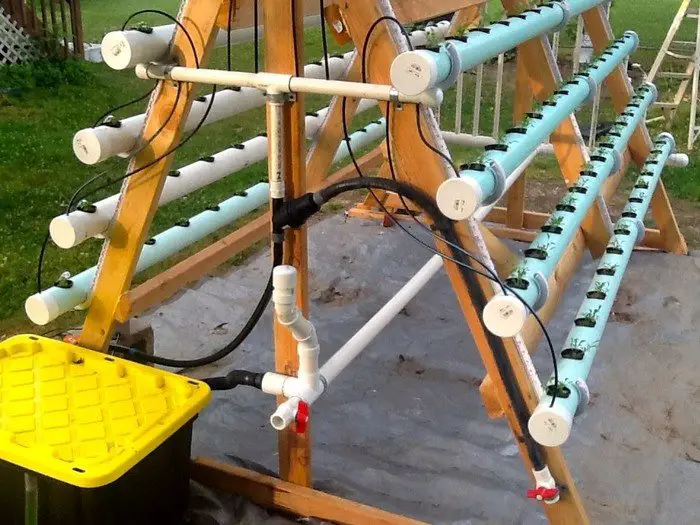

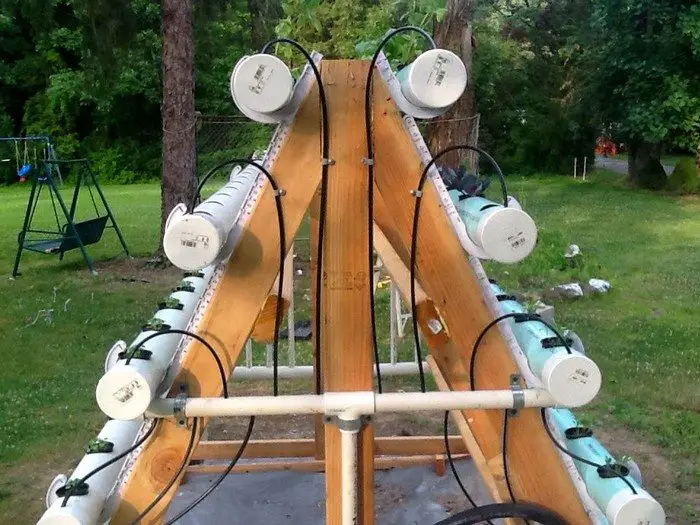
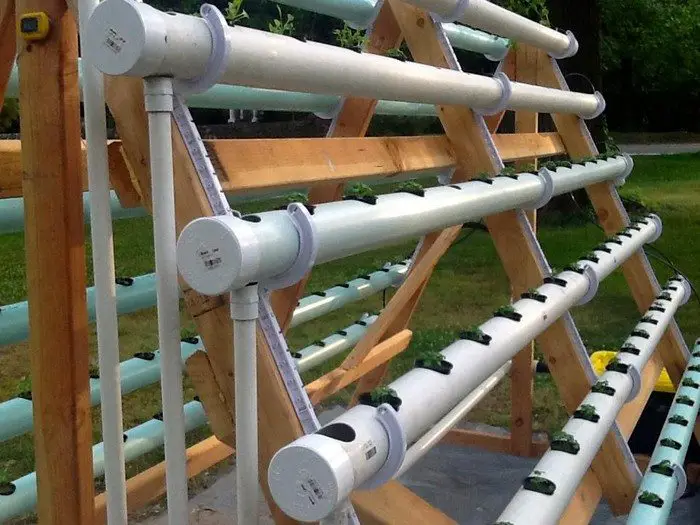
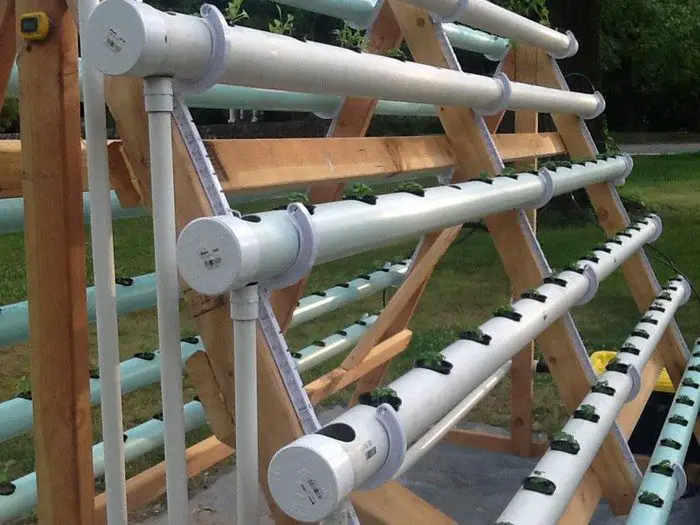
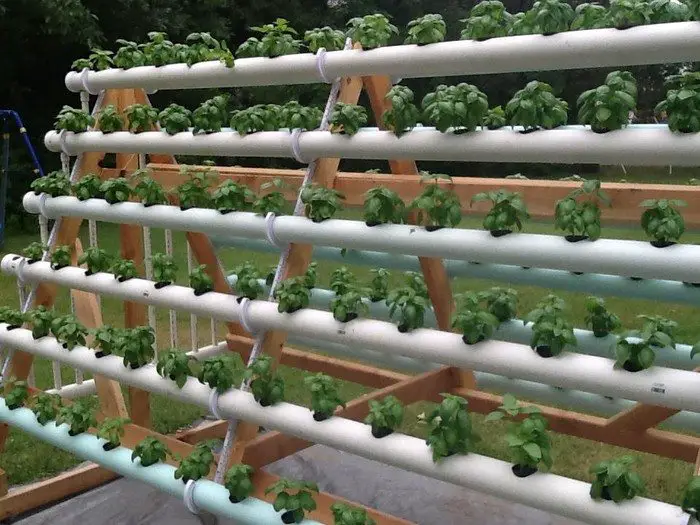
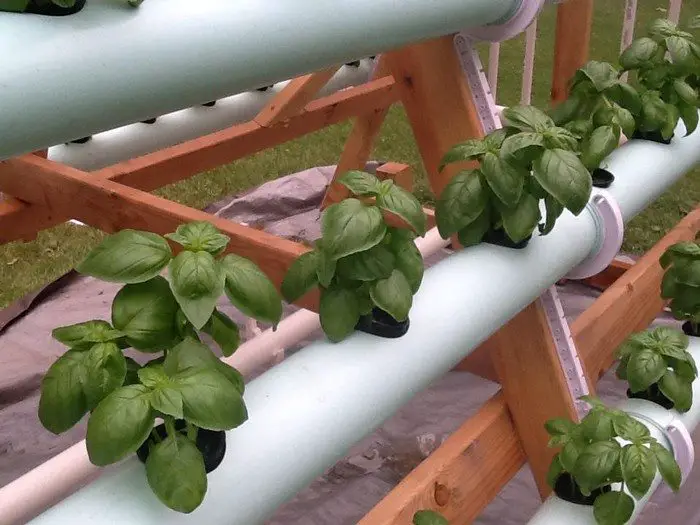
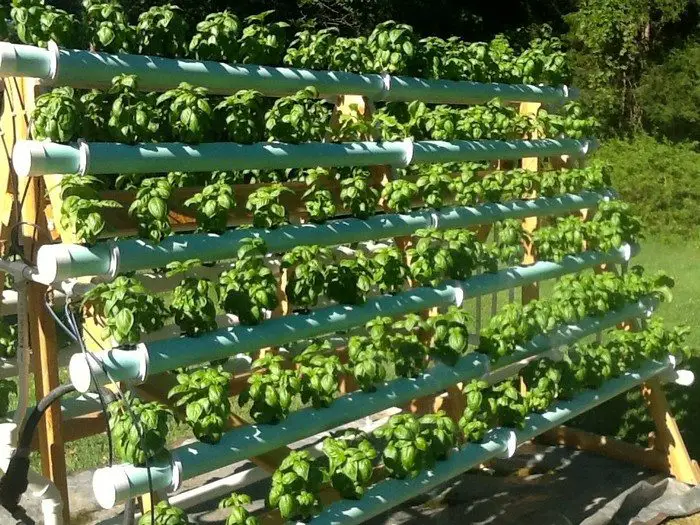
Thanks to Greenerways for this great project. You can watch the tutorial here:
Benefits of an A-Frame Hydroponic System
Hydroponics gardening has become rather popular, especially for people with limited space. Growing different plants in small areas can be accomplished quite effectively with an A-frame hydroponic system. This vertical arrangement simplifies plant care, maximizes developing capacity, and improves efficiency. Below, we shall discuss the main advantages of using an A-frame hydroponic system for your garden.
Maximized Growing Space
The ability of an A-frame hydroponic system to maximize the given space is among its main benefits. While conventional gardening techniques call for big, level spaces for planting, this system presents a vertical substitute. Growing up to twice as many plants as in standard garden beds is possible. Urban gardeners or anyone with a small backyard will find this perfect. Using vertical space will help you grow more plant diversity inside the same footprint, so optimizing every inch of your garden.
Easy Access and Maintenance
Using an A-frame hydroponic system, you can care for your plants without stooping or kneeling. The higher structure makes maintaining plants far simpler. You can check plant development, cut leaves, and pick produce without straying your back. Older gardeners or those with limited mobility will find this simplicity of access especially helpful. Moreover, it saves time since you can more effectively fertilize your plants, water them, and check for pests.

Water Efficiency
The water efficiency of hydroponics systems is well-known. Thus, the construction of an A-frame hydroponic system is not different. Because of runoff and soil absorption, traditional gardening can waste a lot of water. By contrast, an A-frame hydroponic system uses a recirculating water approach. Water is pumped from a reservoir, runs through the system to hydrate the plants, and then returns to the reservoir.
This closed-loop system cuts waste and water consumption. This system is a sustainable means of growing plants while preserving water for people living in areas experiencing water shortages.
Increased Crop Yield
An A-frame hydroponic system can increase crop yields. The regulated surroundings let you monitor the water and nutrients your plants receive. These components can be changed to encourage faster and better development, producing more successful plants. Growing leafy greens, herbs, and some fruits like strawberries depends especially on this system. Through ideal growing conditions, the A-frame construction increases plant output.
Ideal for Urban Settings
An A-frame hydroponic system is ideal for those who live in metropolitan environments with little outside space. The lack of a traditional garden often limits many urban gardeners. With this vertical arrangement, you can create a useful garden out of a balcony, rooftop, or small backyard. Although the A-frame architecture offers enough space for plants to flourish, it fits nicely in confined areas. This system can grow a range of produce even indoors under the correct environment.
An A-frame hydroponic system has many benefits for new and experienced gardeners alike. From optimizing space and water savings to increasing accessibility of plant care, it’s a flexible answer for contemporary gardening. This system can improve your gardening experience and produce amazing results whether your goals are fruit, vegetable, or herb growing. An A-frame hydroponic system’s vertical design, efficiency, and simplicity of use will help you grow plants differently.
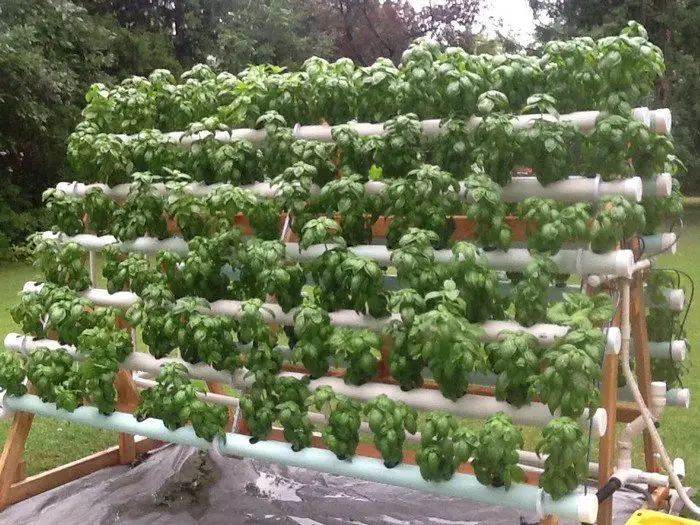
Different Crops to Grow in an A-Frame Hydroponic System
In smaller areas, an A-frame hydroponic system is a great approach to raising several crops. For novice and experienced gardeners, this system provides flexibility about what you can plant. From fruit to leafy greens, many crops flourish in the regulated environment of an A-frame hydroponics system.
Below, we’ll explore some of the best-growing crops in this setup.
Leafy Greens
Leafy greens are among the most often grown vegetables in an A-frame hydroponics system. Not needing a deep root system, plants like lettuce, spinach, and kale flourish in this environment. The consistent water and nutrients encourage quick development, which lets you pick greens more often. These crops maximize the given space by being suited for vertical farming.
Herbs
Another great choice for growing in an A-frame hydroponics system is herbs. Basil, cilantro, parsley, mint, and thyme work well in this arrangement. The controlled environment guarantees their correct water and nutrient intake, generating tasty, healthy herbs. Herbs also occupy little space, so you can grow several kinds at once in a small area.

Strawberries
Strawberries are a perfect fruit crop for an A-frame hydroponics system. Their small size and shallow root structure are perfect for vertical development. By providing ideal light and nutrient levels, you can create sweet, juicy strawberries throughout the growing season. An A-frame system lets you grow many strawberry plants in a small area by allowing you to stack plants in layers.
Peppers
Well-suited for hydroponics are peppers, including bell peppers and chili peppers. An A-frame hydroponic system’s nutrient-rich environment is where they flourish and gain from the vertical arrangement, allowing more airflow and light access. Although peppers need more room than herbs or leafy greens, their growth can be accommodated with the A-frame construction, optimizing yield.
Cucumbers
Another crop grown successfully in an A-frame hydroponics system is cucumbers. The A-frame’s vertical design helps to support their vine growth pattern even if they can grow rather big. Proper training and pruning will help cucumbers grow up the frame, so optimizing the vertical space. The constant water supply guarantees the cucumbers stay hydrated, so fresh and tasty fruits are generated.
An A-frame hydroponic system’s adaptability lets you produce a range of crops, from fruits to leafy greens. Maximizing space and giving plants the nutrients they need makes it simple to create a profitable garden, even in small areas. Whether you emphasize herbs, fruits, or vegetables, an A-frame hydroponics system is a sensible and quick approach to producing robust, healthy crops.
Conclusion
Using an A-frame hydroponic system offers a space-efficient way to grow a wide variety of crops. This system maximizes vertical space and provides optimal conditions for plants to thrive. It’s an excellent solution for gardeners looking to boost productivity in small areas.
We have a more efficient gardening system. Check out our vertical garden project next!





